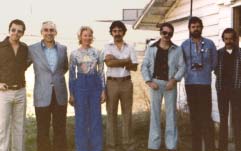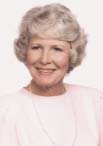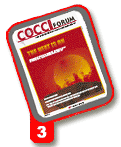COCCI People - Giant Leaps
Joyce Johnson forged new frontiers in coccidiosis control
 Joyce Johnson with a group of
poultry technical specialists from
Latin America and Asia during a
training seminar in 1979.
|
Remember America in 1969?
Joe Namath and the upstart
New York Jets shocked the football
establishment by guaranteeing a
victory in Super Bowl III, Midnight
Cowboy captured the Oscar for Best
Picture, the Fifth Dimension took home
a Grammy for Aquarius/Let the
Sunshine In and the so-called Miracle
Mets won baseball's World Series.
In the same year, astronaut Neil
Armstrong stepped boldly on the moon
while proclaiming "one small step for
man, one giant leap for mankind." That
event changed the world forever.
1969 was also a newsworthy year in
the universe of poultry parasitology.
The University of Georgia (UGA)
Department of Poultry Science hosted
the first-of-its-kind international
Coccidiosis Symposium. A UGA
research technician named Joyce
Keener Johnson introduced a little program
she developed for measuring
gross intestinal lesions in chickens
infected with this major protozoan disease.
While her protocol was enthusiastically
received by the 150-some industry
professionals who attended the conference,
Johnson never dreamed her
lesion scoring system would change
the world of coccidiosis management
forever.
Landmark System
This landmark lesion scoring scheme,
complete with colored slides, came to
be known not only as the Johnson-Reid
Lesion Score System, named for the
inventor and her mentor, W. Malcolm
Reid, but also as an indispensable
benchmark for all scientists working
with cocccidia throughout the world.
Lesion scoring had long been a commonly
accepted criterion for determining
the pathogenicity of coccidial
species. However, no previous
attempts had been made to standardize
and describe the scoring scale to evaluate
the severity
of infection
until Joyce
Johnson tackled
this challenging
mission
at Reid's
suggestion.
"The biggest
benefit of
the Johnson-
Reid Lesion
Score System
was that it provided
an easily learned tool to measure
the effects of anticoccidials and vaccines,"
says parasitologist Donal
Conway, an Asbury, N.J.- based consultant
in pharmaceutical product
development.
"The system had a notable impact in
the late 1960s and 1970s when
ionophores were first being developed.
It was still important in 2000 when the
newest synthetic anticoccidial,
diclazuril, was approved by the FDA,"
Conway asserts.
Coccidiosis lesion scoring according
to the Johnson-Reid System is now the
suggested methodology for all anticoccidial
protocols submitted to the FDA
for approval and for vaccine protocols
submitted to the USDA.
"Even today, everyone who does a
coccidiosis paper has to reference that
Johnson and Reid work," says Dr. Greg
Mathis, president of Southern Poultry
Research, Inc. (SPR), based in Athens,
Ga. The historic Johnson and Reid paper titled "Anticoccidial Drugs:
Lesion Scoring Techniques in Battery
and Floor-Pen Experiments with
Chickens" was published in 1970 in
Experimental Parasitology.
A Wealth of Experience
After Johnson completed her Masters
degree under Reid's tutelage in 1963,
she remained in the UGA Poultry
Science Department for 33 years. As a
Research Technician III, the Alcoa,
Tenn., native worked for Reid for 18
years, then for Peter L. Long for 12
years, and finally for Larry McDougald.
Reid's research focused on chemotherapy,
Long's centered on immunology,
while McDougald's is devoted to both
chemotherapy and cellular immunology.
In 1994, Mathis hired Johnson to
work for his firm, which conducts
research for the poultry and pharmaceutical
industries. Approximately onethird
of SPR's clients, including
Schering-Plough Animal Health, are
involved with some aspect of coccidiosis
research.
"What's amazing to me is that so
many people having what they thought
were new ideas for coccidiosis research
would contact us, and Joyce would
always tell them 'we've already done
that'," Mathis adds. "Joyce was familiar
with all the facets of coccidiosis and
anyone who knew anything about coccidiosis
knew Joyce."
According to Conway, Johnson continually
challenged her colleagues to
hone in on the key questions associated
with evaluating coccidiosis, anticoccidials
and vaccines:
"� How severe is the infection?
"� To what extent is the coccidial infection
affecting feed consumption, feed
conversion and weight gain?
"� Is the product working? If so, how
effective is the anticoccidial program?
"� What is the cost to treat or vaccinate
the flock?
Celebrating the Contributions of a Cherished Colleague
Tragically, Joyce Johnson was killed in an
automobile accident on the morning of January
25 of this year, en route to her job at Southern
Poultry Research, Inc. (SPR), Athens, Ga. |
'Walking Repository'
Besides lesion scoring, Johnson was
involved with other poultry health
issues, including UGA gnotiobiotic
research emphasizing Histomonas and
nematodes of chickens. While working
with Long, she helped to develop
chicken coccidia for use in broiler vaccines.
Johnson also attenuated strains
of coccidia that lose some of their pathogenicity when propagated
in chicken eggs.
"She was a walking
repository of all of the information
on coccidiosis,"
McDougald emphasizes, noting
that Johnson co-authored
44 research papers and four
book chapters.
At SPR, Johnson helped
design a number of important
research protocols,
including immunity studies
that in 1997 led to the commercial
introduction of
Coccivac-B via the hatchery
spray method.
"So many advances in
poultry epidemiology and
the processing of new scientific
ideas were dependent
on the quality of work Joyce
Johnson was able to sustain
throughout her entire
career," Conway emphasizes.
"Her contributions to
the poultry industry were
immeasureable."
Source: CocciForum Issue No.3, Schering-Plough Animal Health.








